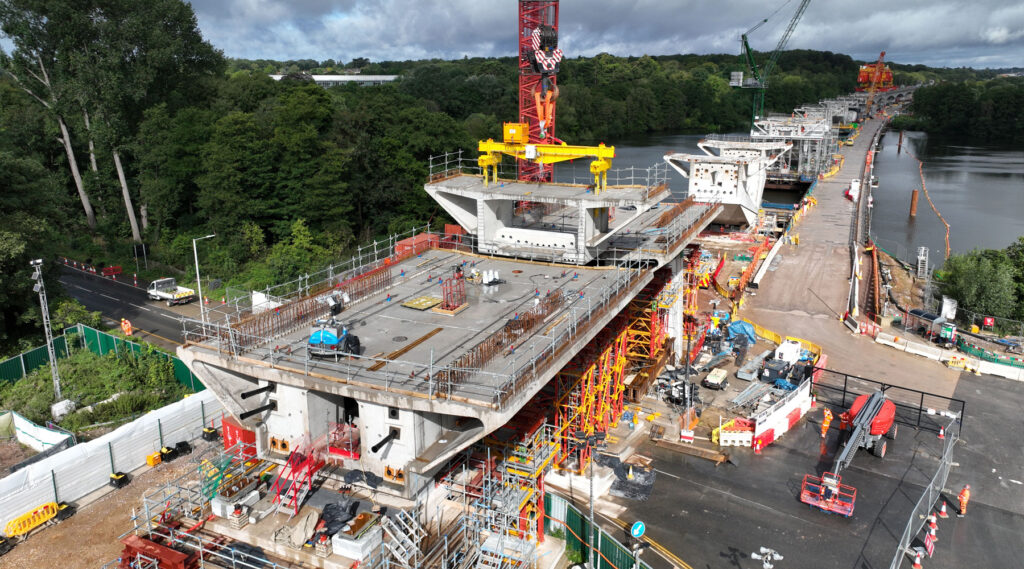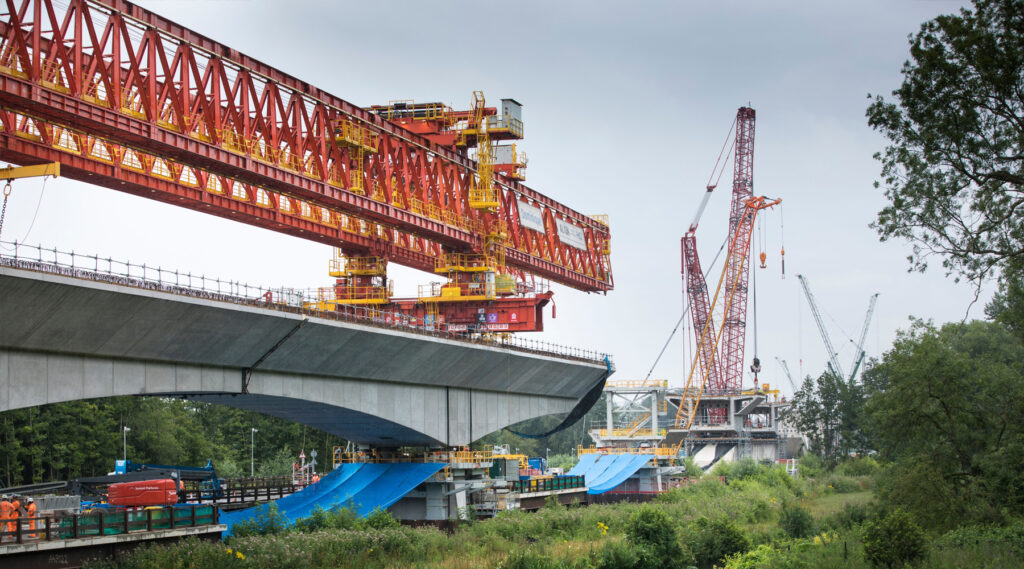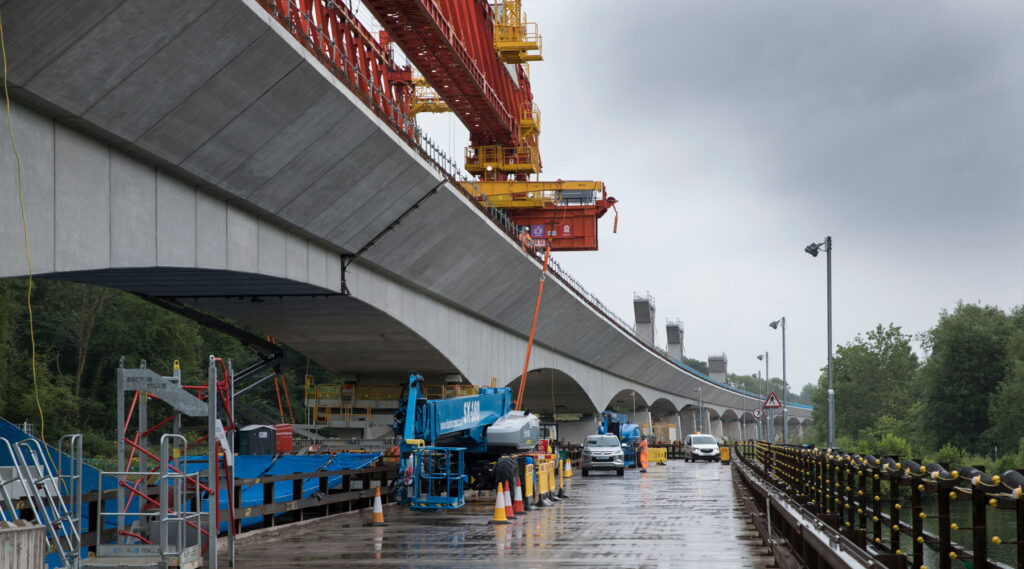Over the past few weeks, HS2 has been moving a 40-metre section of the long Colne Valley viaduct into place over a main road in west London.
HS2 had to close the Moorhall Road near Harefield, in order to bring in cranes to lift eleven of the 115 to 130-tonne segments into position over the road. These were then strengthened with internal steel cabling to complete the span.
Normally, most of these segments are slotted into place by a giant 700-tonne ‘launching girder’ – the only one of its kind in the UK.
However, HS2’s engineers used a different approach at Moorhall Road.
The launching girder was still a few weeks away from the road, so they would have expected to close the road when it arrived – which would be a problem for local road traffic as that would have been when schools were back and the road was busy. Building this one span using cranes by closing the road during the quieter school holidays means that the launching girder will be able to roll right over the road without affecting it.
The viaduct is being built by HS2’s main works contractor Align JV – a team made up of Bouygues Travaux Publics, Sir Robert McAlpine, and VolkerFitzpatrick.
Align’s Surface Operations Director, Derek van Rensburg, said: “Having the flexibility to introduce a crane to complete the span across Moorhall Road during the summer holidays rather than using the launching girder, thereby minimising the impact on the local community, is all credit to the Align team involved, working with our supply chain partners and in particular VSL, which together delivered the work safely.”
To allow for the viaduct’s curve, each of the one thousand segments that form the arches and deck are slightly different – and all are manufactured at a temporary factory set up close by, with direct access to the M25.
The road reopened last Friday.
When completed, the HS2 viaduct will stretch for more than two miles across the Grand Union Canal, River Colne, local roads and a series of lakes on the outskirts of London between Ruislip and the start of the Chiltern tunnels.










A complete waste of tax payers money ! It won’t benefit anyone accept the contractors .
Should be stopped now.
The project is too far advanced now, scrapping it would be a colossal waste of money. Let’s get the job done properly and benefit from the extra capacity, not least on the classic rail network.
I used to stand on Kings Langley station waiting for a (often delayed) train home, watching trains on the WCML fast lines running through as often as the signals permitted. We need HS2.
HS2 is basic and essential infrastructure. It’s worth the money and it must be built. Amidst the political wrangling the engineers on site are getting on with the job.
And it’s the politicians who cause the delay and cost over runs due to changing their minds and going for short term delays and changing project scope to ‘save money’ but which end up costing more in the end.
And HS2 is the classic example of that.
The Olympics worked here in terms of infrastructure because once the plans were settled there were no vanity changes allowed.
There is a bit of a kerfuffle in Australia at the moment re the rebuilding of the Gabba for the 2032 Olympics at a cost of AUS$ 2.7bn
The rebuild is a desire of the politicians / sports bodies and isn’t and wasn’t required by the IOC yet that 2.7bn is going down as an Olympic expense. The head of the Australian Olympic Committee even said that to a Parliamentary Committee this week
It’s amazing stuff, certainly – those wires are the post-tensioning that Faical mentions in the video – and the 1960s motorway flyovers like the Westway were built in the same way. But with no work at Euston for another decade, let’s hope the viaduct doesn’t end up featuring on a 2030s’ episode of ‘Abandoned Engineering’…
Does anyone know what supports each segment as it is dropped into place next to the previous one? Why doesn’t it just fall to the ground? The video mentions steel cables that come later, but I can’t work out what supports it to stay in place until then. I’m sure there is a simple explanation, but it has puzzled me for a long time as I also follow the building of the Namma Metro in Bangalore on Skyscraper City website where they do the same thing with the launching girders.
The mating surfaces of each concrete segment have keys cast in. Dominique, the launching girder, simultaneously lowers a pair of segments into their approximate postions at each end of the section of viaduct being worked on. The Gorilla glue is smeared over the jointing faces and Dominique gently draws these two new segments into their final positions at opposite ends of that particular section thus ensuring balance on the supporting pier. The cables are tensioned between the two new pieces before Dominique fully releases them to the forces of gravity. Each span, necessarily, is left with a small gap midway between piers and these are filled ‘by hand’.
They must have great faith in the glue holding the segments in place to carry the weight of the segments, the weight of the train traffic and dealing with the vibrations. I hope we are not going to see it on ” Mega Disasters ”
as usual the government kept stalling/changing their minds, which spiraled the cost
Just like the millenium dome and several other projects
They don’t use glue to hold the segments together – no idea where you got that idea from.